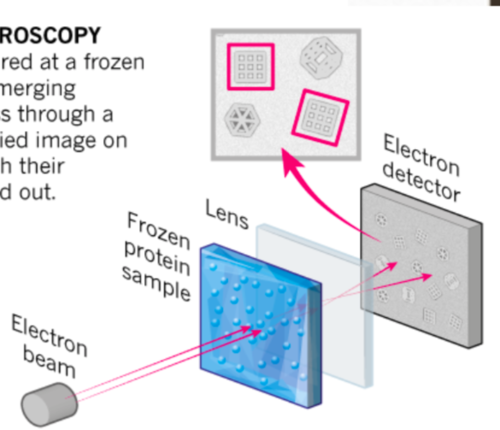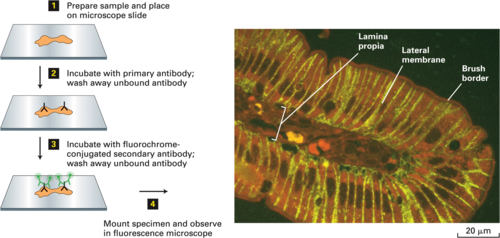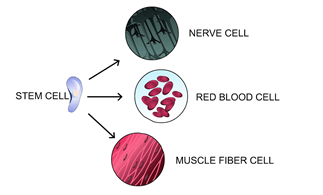- IB DP Biology 2025 SL- IB Style Practice Questions with Answer-Topic Wise-Paper 1
- IB DP Biology 2025 HL- IB Style Practice Questions with Answer-Topic Wise-Paper 1
- IB DP Biology 2025 SL- IB Style Practice Questions with Answer-Topic Wise-Paper 2
- IB DP Biology 2025 HL- IB Style Practice Questions with Answer-Topic Wise-Paper 2
Magnification Formula and Units
mm –> μm –> nm = x1000
nm –> μm –> mm = /1000
Image = Actual size size of image/magnification
*Tip for working out magnification provided an image
—> The little bar on either corner will give you the actual size of the image
–> For the image, you should measure with a ruler the bar in mm. After that, convert that mm to the unit given by the bar (actual size)
Graticules and Magnification
In the diagram, the stage micrometer has three lines each 100 µm (0.1 mm) apart
Each 100 µm division has 40 eyepiece graticule divisions
40 graticule divisions = 100 µm
1 graticule division = number of micrometres ÷ number of graticule division
1 graticule division = 100 ÷ 40 = 2.5 µm this is the magnification factor
The calibrated eyepiece graticule can be used to measure the length of the object
The number of graticule divisions can then be multiplied by the magnification factor:
graticule divisions x magnification factor = measurement (µm)
Electron microscopy + advantages
electron microscope is commonly used to view cells and cellular structures. Rather than passing light through a specimen, electron microscopes pass a beam of electrons through a specimen. Electrons will be absorbed by the denser parts of the sample, and scattered or able to pass through less dense areas, after which they are picked up by an electron detector and used to form an image.
Advantages:
– High resolution – provides much higher resolution than light microscopy, which enables researchers to examine the ultrastructure of cells and organelles with exceptional clarity. Additionally, it provides insights into the intricate arrangement and organization of subcellular components, including membranes, mitochondria, endoplasmic reticulum, Golgi apparatus, and more.

Freeze Fracture microscopy + advantages
Freeze fracture microscopy involves freezing a sample and then using a specialised tool to break the sample into small pieces. These small pieces are then observed using an electron microscope to see the internal structure.
Advantages:
– particularly useful technique for being able to visualise structures that are not normally visible, such as the internal plasma membrane.

Cryogenic electron microscopy + advantages
Cryogenic electron microscopy involves freezing a sample to cryogenic temperatures to fix the molecules, making them more firm or stable.
Advantages:
– Freezing the sample improves the resolution of the image formed and reduces damage that may occur from the electron beam.

immunofluorescence microscopy (light)
Immunofluorescence involves the use of fluorescently labeled antibodies to detect specific proteins or antigens within cells or tissues. It enables researchers to target and visualize specific molecules of interest.

Fluorescent dyes in light microscopy
Fluorescent stains are small molecules that can selectively bind to specific cellular components or structures. They absorb light at a specific wavelength and emit light at a longer wavelength, resulting in fluorescence. These stains can be applied to fixed cells or tissues, allowing researchers to visualize and study various aspects of cell biology.

Why do typical cells contain DNA as a genetic material, a cytoplasm composed mainly of water and a plasma membrane made of lipids encapsulating the cell contents?
Typical prokaryotic and eukaryotic cells contain DNA as genetic material for the storage and transmission of hereditary information.
The cytoplasm, composed mainly of water, supports cellular processes to provide a medium for chemical reactions.
The plasma membrane, made of lipids, encapsulates the cell contents, to allow the passage of substances in and out, maintaining cell integrity, and facilitating cellular communication
Eukaryotic
A cell is characterized by the presence of a nucleus and other membrane-bound organelles (mitochondria, r.e.r, gogli etc).
Examples:
– Eukaryotes can be unicellular (protists)
– Multicellular (fungi, plants and animals).
Differences:
– Larger than prokaryote
– Has a nucleus
– Reproduction through mitosis and meiosis

What components should be included in a cell model of a prokaryote?
Cell Wall, Plasma membrane, Cytoplasm, Naked DNA, 70s ribosomes, plasmid
Prokaryotic (Define, Examples, Differences)
An organism whose cells lack a true nucleus, instead they have a nucleoid region where a sinlge circular DNA is located.
Exampels:
– Bacteria and Archea
– common bacteria such as e coli
Differences:
– Prokaryotes reproduce asexually using the process of binary fission
*A form of asexual reproduction in single-celled organisms by which one cell divides into two cells of the same size
– Lot smaller than Eukaryote
– no membrane-bound organelles

What components should be included in a cell model of a eukaryote?
Plasma membrane, cytoplasm, mitrochondria, Nucleus, 80s ribosomes, smooth and rough ER, golgi apparatus, vesicle, vacuole, cytoskeleton, centrioles (in animal cells), chloroplast and valuables (if plant cells)
Compartmentalisation
Eukaryotic cells contain membrane-bound cytoplasmic organelles, such as mitochondria and chloroplasts. This compartmentalisation allows for the interior of the organelles to have separate conditions to the cytoplasm of the cell. The advantages of compartmentalisation include:
– the ability to create higher concentrations of certain substances within organelles
– the ability to separate toxins and potentially damaging substances from the rest of the cell. For example, hydrolytic enzymes can be stored in structures called lysosomes, away from the cell cytoplasm
– control over conditions inside organelles (such as pH) to maintain the optimal conditions for the enzymes that function in those parts of the cell
These membrane-bound organelles include nucleus, RER and SER, Golgi Apparatus, Mitochondria, Chloroplasts, Lysosomes, Vacuoles, chloroplast, and vacuoles.
Functions and importance of Prokaryotic cell structures (Cell Wall, Plasma membrane, Cytoplasm, Capsule, 70s ribosomes, plasmid, pili, flagella, nucleoid *naked dna) (E.COLI as an example)
1. Cell Wall
– Function: Provides structural support and maintains the shape of the cell.
– Importance: Protects the cell from changes in osmotic pressure and external environmental conditions.
2. Plasma Membrane (a phospholipid bilayer):
– Function: Regulates the passage of substances in and out of the cell.
– Importance: Controls nutrient intake, waste elimination, and communication with the environment.
3. Cytoplasm:
– Function: Houses cellular components and supports cellular processes.
– Importance: Serves as a medium for chemical reactions and the movement of cellular structures.
4. Nucleoid:
– Function: Contains the genetic material (DNA) of the cell.
– Importance: Stores the genetic information necessary for cellular functions and reproduction.
5. Ribosomes:
– Function: Site of protein synthesis (translation).
– Importance: Produces proteins essential for various cellular functions.
6. Flagella:
– Function: Facilitates cell movement (motility).
– Importance: Allows the cell to navigate its environment in response to stimuli.
7. Pili (Pilus, plural):
– Function: Facilitates attachment to surfaces and exchange of genetic material through conjugation.
– Importance: Enhances the ability to adhere to substrates and promotes genetic diversity.
8. Plasmid
– Function: Carry accessory genes that may provide advantages, such as antibiotic resistance, virulence factors, or metabolic capabilities.
– Importance: Contribute to genetic diversity, adaptation to environmental challenges, and the evolution of prokaryotic cells.
9. Capsule
– Function: Provides protection and aids in adherence to surfaces.
– Importance: Offers resistance to desiccation and helps evade the host immune system.
Functions and importance of eukaryotic cell structures including plant cells and animal cell exceptions (Plasma membrane, cytoplasm, mitochondria, Nucleus, 80s ribosomes, smooth and rough ER, Golgi apparatus, vesicle, vacuole, cytoskeleton, lysosomes, Cillia and centrioles (in animal cells), cell walls and chloroplast and valuables (in plant cells)
This will scetion will only include: Nucleus, Vesicle, Lysosomes, Cillia, Centriole and vacuoles
1. Nucleus:
– Function: Stores genetic material (DNA), regulates gene expression.
– Importance: Controls cellular activities and hereditary information.
2. Vesicle:
– Function: Transport and storage of various substances.
– Importance: Facilitates intracellular transport and compartmentalization.
3. Vacuole:
– Function (Plant Cell): Stores water, nutrients, and waste products.
– Importance (Plant Cell): Provides structural support and maintains turgor pressure.
4. Lysosomes:
– Function: Contain digestive enzymes to break down cellular waste.
– Importance: Removes damaged organelles and cellular debris.
5. Cilia (Animal Cells):
– Function: Facilitates cell movement and sensory functions.
– Importance: Involved in movement and cellular communication in some cells.
6. Centrioles (Animal Cells):
– Function: Organizes spindle fibers during cell division.
– Importance: Essential for mitosis and cell division.
*Part 1 (Components of Eukaryotic cell structures) Here are a few membrane-bound organelles you need to know more in detail about: (Mitochondria, RER, SER, golgi apparatus)
Mitrochondria
– Has a double membrane
– A smooth outer membrane and a folded inner membrane
– The folds are referred to as cristae
– Site of ATP production by aerobic respiration (if fat is used as a source of energy it is digested here)
RER
– The consists of flattened membrane sacs, called cisternae
Often located near to the nucleus
– 80S Ribosomes are attached to the outside of the cisternae are ribosomes
– rER synthesizes proteins which are transported, by vesicles, to the Golgi apparatus for modification before secretion outside the cell
SER
– no ribosomes present
– Has unique enzymes embedded in the phospholipid bilayer
– Produces sex hormones such as oestradiol and testosterone
– Detoxification of drugs in the liver
– Transportation of lipid-based compounds
– Helping the liver to release glucose into the bloodstream
Golgi Apparatus
– This organelle also consists of flattened membrane sacs called cisternae, like rER.
– Different to rER:
—–>No attached ribosomes
—–>Often sited close to the plasma membrane
—–>The cisternae are shorter and more curved that those of the rER
– The Golgi apparatus processes (modifies) proteins from from the rER. The proteins are then repackaged in vesicles for secretion outside the cell.
Part 2* (Components of Eukaryotic cell structures) Here are a few membrane bound organelles you need to know more in detail about: (cytoskelton and chloroplast)
Cytoskeleton
– A network of fibres in eukaryotic cells
Composed of protein like:
—->actin filaments(microfilaments) – cell division and movement
—–>intermediate filaments, which reinforce shape and anchor organelles
—-> Microtubules, which shape and support the cells and provide a movement path for some organelles
It has the following functions:
—->Maintaining cell shape
—->Anchoring some organelles
—->Aiding cellular movement
—–>Provides the means for some organelles to move in the cell
Chloroplast
– Many, but not all, plant cells contain chloroplasts
– A double membrane surrounds the chloroplast
Inside are stacks of thylakoids
– Each thylakoid is a disc composed of a flattened membrane
– The shape of chloroplasts is variable but is usually ovoid
– The site of photosynthesis and hence where glucose is produced.
– Starch grains maybe present if photosynthesis is happening quickly
Gram- positive staining
We can classify bacteria based on their ability to retain a dye called crystal violet
Gram-positive bacteria have a cell wall that can absorb the dye and thus hav a violet or blue appearance
Gram- negative bacteria do not absorb the dye. Examples of Gram – positive are Bacillus and staphylococcus

Process of life unicellular organisms (paramecium)
1. Growth
– As it consumes food, the Paramecium enlarges. Once it reaches a certain size it will divide into two daughter cellsDictionary
2. Movement:
– The wave action of the beating cilia helps to propel Paramecium in response to changes in the environment, for example, towards warmer water and away from cool temperaturesDictionary
3. Response to stimuli
– Paramecium are able to detect changes in the water temperature around them and move in response to seek warmer temperatures
4. Homeostasis
– A constant internal environment is maintained by collecting excess water in the contractile vacuoles and then expelling it through the plasma membrane. This process is called osmoregulation and helps Paramecium and Chlamydomonas to maintain their water balance
5.nutrition
– Paramecium is a heterotroph. It engulfs food particles in vacuoles where digestion takes place. The soluble products are then absorbed into the cytoplasm of the cell. It feeds on microorganisms, such as bacteria, algae and yeasts
6. reproduction
– It can carry out both sexual and asexual reproduction, though the latter is more common. The cell divides into two daughter cells in a process called binary fission (asexual reproduction)
7. excretion
– Digested nutrients from the food vacuoles pass into the cytoplasm, and the vacuole shrinks. When the vacuole, with its fully digested contents, reaches the Paramecium’s anal pore, it ruptures, expelling its waste contents to the environment
8. Metabolism
– Most metabolic pathways happen in cytoplasm

Chlamydomanas
1. Growth
– Production of organic molecules during photosynthesis and absorption of minerals causes the organism to increase in size. Once it reaches a certain size it will divide into two daughter cells
2. Movement:
-The flagella of the Chlamydomonas rotates, moving the organism towards more favourable conditions, such as higher light intensity
3. Response to stimuli
– Chlamydomonas senses light changes in its environment using its eye spot and then moves toward a brighter region to increase the rate of photosynthesis
4. Homeostasis
– A constant internal environment is maintained by collecting excess water in the contractile vacuoles and then expelling it through the plasma membrane. This process is called osmoregulation and helps Paramecium and Chlamydomonas to maintain their water balance
5.nutrition
– Chlamydomonas is an autotroph; it uses its large chloroplast to carry out photosynthesis to produce its own food
6. reproduction
– It can carry out both sexual and asexual reproduction. When Chlamydomonas reaches a certain size, each cell reproduces, either by binary fission or sexual reproduction
7. excretion
– It uses the whole surface of its plasma membrane to excrete its waste products
8. Metabolism
– most metabolic pathways happen in the cytoplasm

Atypical cell structure in eukaryotes
1. Aseptate fungal hyphae
2. Skeletal Muscle
3. Red Blood cell
4. Phloem sieve tubes
Aseptate Fungal Hyphae
Number of Nuclei: Multinucleate
Explanation: Aseptate fungal hyphae are elongated, thread-like structures that lack septa (cross-walls). They contain multiple nuclei distributed along the length of the hypha.

Skeletal Muscle
Number of Nuclei: Multinucleate
Explanation: Skeletal muscle cells, or muscle fibers, are long and cylindrical. They are multinucleate due to the fusion of multiple myoblasts during development.

Red Blood Cell
Number of Nuclei: Anucleate (lacks nucleus)
Explanation: Mature red blood cells, or erythrocytes, do not contain a nucleus. They eject their nucleus during development to create more space for hemoglobin, allowing for efficient oxygen transport.

Phloem sieve tube elements
Number of Nuclei: Usually absent or one per cell
Explanation: Phloem sieve tube elements are specialized plant cells involved in the transport of nutrients. They often lack a nucleus or have a reduced nucleus to maximize the space for sap flow.

Endosymbiosis
A theorized process in which early eukaryotic cells were formed from simpler prokaryotes.
Rather than being digested, these cells remained inside the host cell, carrying out aerobic respiration and providing energy to their host cells, evolving into mitochondria.
For some eukaryotes, subsequent endocytosis of a prokaryotic cell that could convert light energy into chemical energy, probably a cyanobacterium, resulted in the evolution of chloroplasts
Evidence for endosymbiosis
1. have double membranes. It is thought that the inner membrane was formed from plasma membrane of the endocytosed prokaryotic cell, and the outer membrane is thought to have formed from the vesicle in which the cell was taken up into the ancestor of eukaryotic organisms
2. have circular naked DNA, as is found in prokaryotes
3. have 70S ribosomes, the same size as the ribosomes in prokaryotes, rather than the 80S ribosomes in eukaryotic cells
4. divide by binary fission like prokaryotic cells, unlike eukaryotic cells, which divide by mitosis
5. are susceptible to some antibiotics, compounds that target prokaryotic structures and metabolic processes.

What is differentiation?
The process by which a cell changes to become specialised for its job
– When undifferentiated cells are exposed to particular environmental conditions they can be triggered to differentiate to become a certain type of specialized cell.

Describe the process of cell differentiation
Cell Differentiation:
– Activates genes for specialized cell function.
– Suppresses irrelevant genes.
– Regulated by the cellular environment.
Human Development:
– Embryonic cells differentiate.
– Gene expression influenced by growth factors.
– Leads to specialized cell types.
Significance:
– Enables larger body size.
– Enhances complexity and adaptability.
– Specialization improves overall functionality.
Describe the evolution of multicellular organisms
Scientists think that multicellularity has evolved repeatedly through a process called cell aggregation. This is where individual cells cluster together, more efficiently obtaining and sharing nutrients and benefiting from group protection from predators. Over time, some of the cells within the cluster were thought to have differentiated to play more specialised roles.
*cell aggregation refers to the process by which cells come together to form a group or a cluster,
